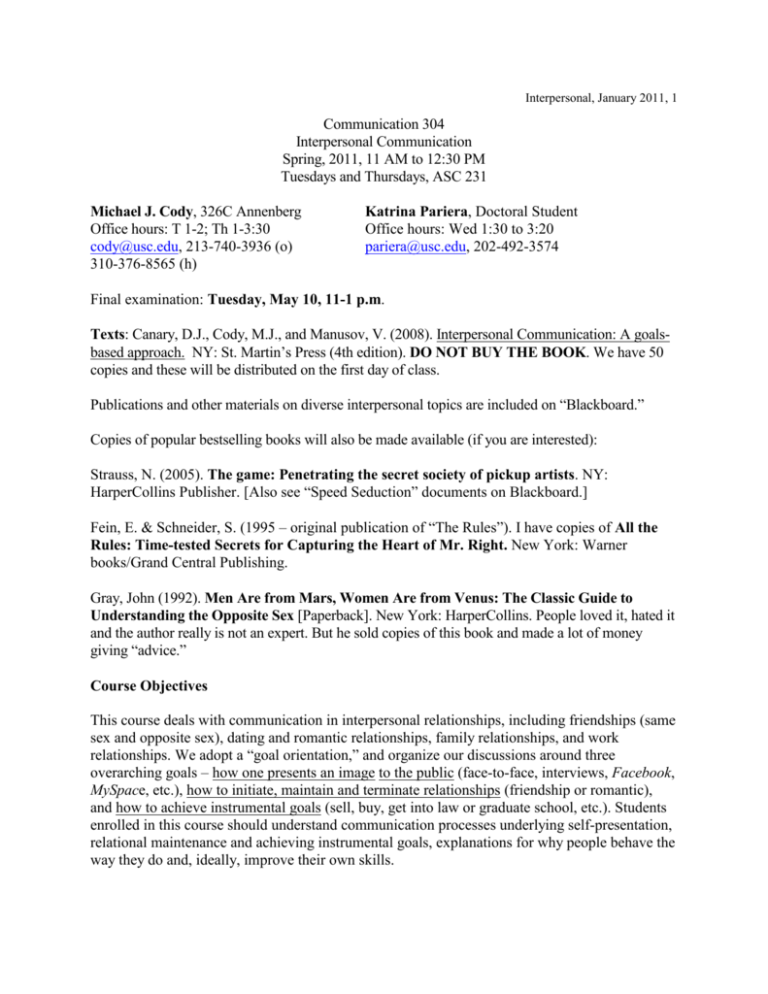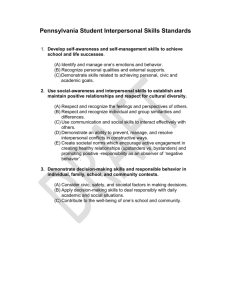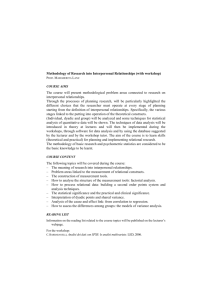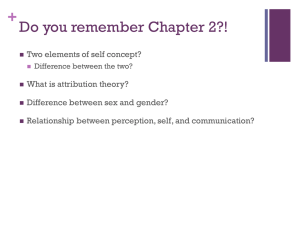Communication 480
advertisement

Interpersonal, January 2011, 1 Communication 304 Interpersonal Communication Spring, 2011, 11 AM to 12:30 PM Tuesdays and Thursdays, ASC 231 Michael J. Cody, 326C Annenberg Office hours: T 1-2; Th 1-3:30 cody@usc.edu, 213-740-3936 (o) 310-376-8565 (h) Katrina Pariera, Doctoral Student Office hours: Wed 1:30 to 3:20 pariera@usc.edu, 202-492-3574 Final examination: Tuesday, May 10, 11-1 p.m. Texts: Canary, D.J., Cody, M.J., and Manusov, V. (2008). Interpersonal Communication: A goalsbased approach. NY: St. Martin’s Press (4th edition). DO NOT BUY THE BOOK. We have 50 copies and these will be distributed on the first day of class. Publications and other materials on diverse interpersonal topics are included on “Blackboard.” Copies of popular bestselling books will also be made available (if you are interested): Strauss, N. (2005). The game: Penetrating the secret society of pickup artists. NY: HarperCollins Publisher. [Also see “Speed Seduction” documents on Blackboard.] Fein, E. & Schneider, S. (1995 – original publication of “The Rules”). I have copies of All the Rules: Time-tested Secrets for Capturing the Heart of Mr. Right. New York: Warner books/Grand Central Publishing. Gray, John (1992). Men Are from Mars, Women Are from Venus: The Classic Guide to Understanding the Opposite Sex [Paperback]. New York: HarperCollins. People loved it, hated it and the author really is not an expert. But he sold copies of this book and made a lot of money giving “advice.” Course Objectives This course deals with communication in interpersonal relationships, including friendships (same sex and opposite sex), dating and romantic relationships, family relationships, and work relationships. We adopt a “goal orientation,” and organize our discussions around three overarching goals – how one presents an image to the public (face-to-face, interviews, Facebook, MySpace, etc.), how to initiate, maintain and terminate relationships (friendship or romantic), and how to achieve instrumental goals (sell, buy, get into law or graduate school, etc.). Students enrolled in this course should understand communication processes underlying self-presentation, relational maintenance and achieving instrumental goals, explanations for why people behave the way they do and, ideally, improve their own skills. Interpersonal, January 2011, 2 The topics we will discuss include friendship formation, self-disclosure, relational growth, escalation, decay, self-presentation, maintenance of friendships, face-to-face influence, conflict styles and/or conflict, online relationships, family influences in studying communication patterns [intergenerational], the effects of divorce (as a “stressor” or “disrupter”), “blended” families, interracial dating, intercultural relationships, and “social support” derived from intimate relationships, family members and even strangers. The instructors will provide a broad-based exposure to research and theory in the area of interpersonal communication, providing examples along the way (usually from movies or television). Second, the instructors will advise and assist students in their individual paper/digital projects and for the production/group projects (described below). In this class, we want you to understand theories and communication processes draw conclusions that are based on research findings, and apply the theory and research to practical examples. Grading Individual Assignment/paper or wiki page 20% of grade on analyzing media examples E-mail as an attachment to cody@usc.edu [See description below] by Midnight Friday, February 11 [We will have you do this assignment first, and early in the semester, because you will be in a group project with students who have similar interests for the group project later in the semester.] Test 1 (multiple choice, true/false) 20% of grade Chapters 1, 2, 3, 4, 5, 14, 15 February 22 Test 2 (multiple choice, true/false) 20% of grade Chapters 6, 7, 8, 9, 10, 11 April 19 Group project and presentation 20% of grade Students will work in groups and make a presentation on specific topics on selfpresentation, flirting, dating, long-distance relationships, humor, etc. See below. April 21, April 26, April 28 Final examination 20% of grade Tuesday May 10, 11 to 1 PM Interpersonal, January 2011, 3 Class Organization and Description of Assignments We will begin lectures in this class on the “fundamentals” in communication (Chapters 1 to 5 in the text book). The topics include “goals,” verbal messages, nonverbal communication, listening, and cognitive processes (stereotypes, etc.). We will also discuss family and personality influences on communication behaviors (Chapters 14 and 15) – because personality and “attachment styles” cut across various types of goals. After Test 1 (February 22) we will discuss what most of you will find the more interesting and important topic areas: Chapter 6, Presenting the self – off line, online, job interviews, celebrities, sports characters, coaches, etc. Although Erving Goffman’s Presentation of self in everyday life dates to 1959, online self-presentations are commonly studied today. Chapter 7, Disclosing the self – Do you reveal personal information, or conceal information? Are topics taboo? Do you disclose too much? Getting to know others. Chapter 8, Defending the self – to police, professors, parents, friends, lovers, etc., when our action is called into question, we have to explain our actions. Some people give excuses for infidelity, others apologize and hope to re-build their public image and trust from others. In today’s world, there are always newer examples of Self-presentation and Defending the self (chapters 6 and 8)[Mel Gibson, Michael Phelps, Michael Vicks, David Letterman, and many others.] This one, by Kanye West, is a sad, sad moment (Sad in part because Leno tries to ‘help’ by bringing up Kanye West’s mother, but he fails to help the situation): http://www.youtube.com/watch?v=z6YrfGE8J-M&feature=related There are many effective and ineffective examples of communicating apologies or excuses. For example: http://www.youtube.com/watch?v=XzytivQsPGI http://www.youtube.com/watch?v=I3l-gRHjUNk Chapter 9, Relational initiation; flirting, dating, communicating interest, attraction, building relationships Chapter 10, Maintaining relationships – friendships (platonic, same and opposite sex friends), maintaining business working relationships, maintaining romance, long-distance relationships, forms of love. Chapter 11, De-escalating relationships; often an understudied issue, but some individuals can be devastated by a breakup, requiring a time to become re-adjusted to life and to relearn one’s earlier “true identity” of who they were before they changed in a relationship. Also, both online and offline research indicates that people break up seasonally: http://bits.blogs.nytimes.com/2010/11/03/using-facebook-updates-to-chronicle-breakups/ Interpersonal, January 2011, 4 Assignments Individual Paper. Analyzing popular media examples of interpersonal communication. There are many reasons why I am distributing the “text book” to class members. Most importantly, there should be a useable “wiki” digital, multi-media text available online – but none is available (yet) and book publishers are hesitant to change. I decided to start creating our own USC “Interpersonal topics” set of links which students here at USC can add to each year. Since links on You Tube come and go and there are always new examples (relational breakups, apologies, we can update a set of the content of and the video examples each semester. Examples from previous semesters can be found on Blackboard (the documents labeled Conflict, Coping with Long Distance Relationships, Forgiveness, Friendship, Impression Management, Online Dating, and Physical Attractiveness are written in the classic “wiki page” format). Every topic we discuss is relevant to daily life, and you should see issues we discuss in popular media – news, movies, television, online, music and even advertising. Each chapter in our book starts with one news story about an important area of interpersonal life. But there are a lot more of these, including scenes from popular media. And celebrities, sports characters and public officials provide more every week. Here is what you do: Select one chapter from the text book on a topic that is personally interesting to you. The topic is not necessarily the whole chapter; but a specific topic like Flirting, coping with Long Distance Relationships, Same-Sex and Opposite Sex Friendships, Platonic Friendships, Personalities and Communication, Online Self-presentation, Self-Disclosure, Deception, Breaking up relationships etc. Compile a list of video clips (movies, television, music videos, even advertisements, online viral projects) that can be used to highlight principles from the chapter – examples of messages, examples reflecting theories or research outcomes (reactions; severing relationships, failed flirting, successful apologies vs. failed; etc.). The Paper: Your paper should be a set of paragraphs that “set up” or describe the importance of each video clip, song, blog page, etc. That is, describe the context, what the message is that is communicated, why is it used, and then describe the consequences of the action. The example should reveal an important element of communication principles relevant to the topic. It should be a good example, or exemplary, of the communication process. Several pages later in this document provide a worked example in the area of Relational disengagement (see pages 8 – 11). There is no page limit or limit on the number of examples, and the content of some chapters will involve more media links (self-presentation, relational escalation, maintenance, disengagement, self-disclosure, non-verbal communication), etc. The grade is based mostly on your description of the relevance of the clip to content in the chapter; followed by whether the grader (Dr. Cody; cody@usc.edu) agrees with you that it is a good example. This paper should be e-mailed to both instructors by Midnight, Friday, February 11th. Dr. Cody grades this and will give feedback right away. Interpersonal, January 2011, 5 Don’t forget that you can include music (songs, videos), and narratives from any particular source (blogs on “modern romance”). You may want to visit the “Wiki Pages First Drafts” folder on Blackboard for ideas, other examples…. Note: If you vividly remember a scene or music video (or even a passage in a book), but cannot locate it anywhere, then simply describe the example in sufficient detail so that the reader will understand the interpersonal communication used, why and the consequences. I say this because I do not want you to spend too much time searching for materials on You Tube, etc. Group Project. Developing Wiki Pages or useful web site, or creating a movie After each person compiles his/her ideas about visual, mediated examples on the content of one chapter, people who selected the same chapter will work collaboratively on “wiki” pages for that content, sharing and compiling examples. Certain “wiki” pages can be “linked” – selfpresentation, “apologies,” “forgiveness,” etc. Groups will work in class (and outside of class time if needed) to create a movie, a website or a wiki page for the chapter or content area (Long Distance Relationships, Coping with Breakups, etc.). Feel free to use or paraphrase sections from the text book (cite the book), and references when creating the wiki pages (again, see the first drafts on Blackboard). Groups will later present 10 minute “mini-lectures” to the class on April 21, April 24 or April 26. Copies will be given to both instructors on the day the group presents. Examples of Wiki-pages for Chapters (appear on Blackboard, an example of a web site for educational purposes (on Long Distance Relationships) appear here: http://www.wix.com/ldr2010/comm-304-group-project Examples of movies appear on my private space on You Tube and we will see some examples of these on Thursday, January 13. Grade of “A:” the creation of pages bridging theory and research (from text) with exemplary cases from diverse media clearly illustrating communication principles. Here are what groups have done recently in this class: In the spring semester of 2010, students focused on The Game and Speed Seduction. Groups completed short movies on the following topics: Negs and Praises (how “players” mix up praising a person and using negative statements to keep others off balance and try to lower a women’s self esteem – and to solicit a defensive reaction) Neutralizing the boyfriend claim Physical setting of the approach “The Rules” versus “The Game” Interpersonal, January 2011, 6 Pick-up lines Isolating the woman Approaching the woman Appealing to women’s emotions Most groups in the fall of 2010 focused on “Strategic Self-Presentation,” and the groups included: Facebook Self-presentations Grooming and maintaining sports figures public images Maintaining parasocial interactions with fans on sports talk shows Flirting (old fashion face to face flirting) Self-presentations on dating web sites Long Distance Relationships -- This group created a very good website Tarnished images of Narcissistic Celebrities (excellent video you will see Thursday January 13). Schedule Day 1, January 11 Day 2, January 13 Introductions, overview. What we have placed on Blackboard. More video/visual examples Day 3, January 18 Read chapters 1 and 2. Fundamentals of Interpersonal Communication Fundamentals of Verbal Messages. Power point slides will contain the highlights of the chapters. Day 4, January 20 Chapter 3. Fundamentals of Nonverbal Communication. Take the test: http://www.bbc.co.uk/science/humanbody/mind/surveys/smiles/index.shtml Day 5, January 25 Science of Sex Appeal (Beauty, liking, attraction, flirting) Day 6, January 27 Finish Nonverbal, flirting and cultural interactions; Know your Flirting style http://connect.ku.edu/tests/flirt/ Day 7, February 1 Day 8, February 3 Chapter 4, Listening Skills Chapter 5. Fundamentals of Social Cognition Day 9, February 8 Chapter 5 continued. Relational expectations, Attribution theory Day 10, February 10 Chapter 14. Personality and self construals (discussed previously in earlier chapters). Complete this survey before February 1, so I can present class averages on some personality measures: http://www.surveymonkey.com/s/InterpersonalCommunication Complete this survey to get your Narcissism score: http://www.usatoday.com/news/health/2009-03-16-pinsky-quiz_N.htm Interpersonal, January 2011, 7 Day 11, February 15 Chapter 15. Attachment styles, family and life span issues Day 12, February 17 Review for Test 1 Day 13, February 22 Test 1 (no lecture follows) Day 14, February 24 Test 1 returned. Discuss Group projects, class time allocated for Group Work Day 15, March 1 Day 16, March 3 Chapter 6, Presentation of Self Chapter 6 continued (some class time will be allocated for Group Work) Day 17, March 8 Day 18, March 10 Chapter 7, Self-Disclosure Chapter 7 continued (some class time will be allocated for Group Work) MARCH 14 – MARCH 18 – Spring Break Day 19, March 22 Day 20, March 24 Chapter 8, Defending the self Chapter 8 continued (some class time will be allocated for Group Work) Day 21, March 29 Day 22, March 31 Chapter 9, Relational initiation Chapter 9 continued (some class time will be allocated for Group Work) Day 23, April 5 Day 24, April 7 Chapter 10, Relational maintenance Chapter 10 continued (some class time will be allocated for Group Work) Day 25, April 12 Day 26, April 14 Chapter11, Relational dissolution Review for Test 2 Day 27, April 19 Day 28, April 21 Day 30, April 26 Day 31, April 28 Test 2 (no lecture follows) Return Tests, start Group Presentations Group Presentations Group Presentations Final examination: Tuesday May 11, 11 AM to 1 PM Students requesting academic accommodations based on a disability are required to register with Disability Services and Programs (DSP) each semester. A letter of verification for approved accommodations can be obtained from DSP when adequate documentation is filed. Please be sure the letter is delivered to the instructors as early in the semester as possible. DSP is open MondayFriday, 8:30 AM – 5:00 PM. The office is in Student Union 301 and their phone number is 213740-0776. Interpersonal, January 2011, 8 Example of media clips and analyses for Individual Paper, using “relational breakups” as the interpersonal topic: In an episode from the television series Sex and the City, Carrie Bradshaw is broken up with on a post-it note. She woke up one morning with the man she was currently dating, Jack Berger, gone and a post-it on her lap top stating “I’m Sorry. I Can’t. Don’t hate me.” This is an example of a non-negotiation negative identity management tactic. This type of tactic is used to create negative emotions that speed up the process of disengagement. Berger’s tactic succeeded not only because the relationship ended, but also because there were not any negotiations. Carrie was so insulted that she had no desire to call him or question his decision. Several of the friends point out “insensitive” ways of breaking up: http://www.youtube.com/watch?v=vPhCvyb5jeQ In Sex and the City, Carrie (Sarah Jessica Parker) breaks up with Aleksandr (Mikhail Baryshnikov) because of their inequitable relationship. Carrie is angry and hurt that he ignored her at the art gallery even though he had originally asked her to sacrifice her own plans to go with him. She tells him that she didn’t come to Paris to be alone while her boyfriend would rather be working than spending time with her. However, Aleksander dismisses her by criticizing her as being overly emotional and irrational. He doesn’t listen to her emotions. This is an excellent example of the principle of “least interest:” The person least interested in initiating and maintain a relationship has more power in it. Carrie wants and desires a relationship and sacrifices to get it started, but he is not going to increase his inputs and commit to the relationship, so it ends: http://www.youtube.com/watch?v=M6DPEpJw6bU&feature=related In the film, American Psycho, Patrick (Christian Bale) coldly breaks up with Evelyn (Reese Witherspoon) by disconfirming her belief that she is important to him. Patrick repeatedly tells her that it’s over but she either ignores him or refuses to believe him. When she tells him that they can’t break up because her friends are his friends and his friends are her friends, he tells her that she can have his friends. She finally realizes that he’s serious and to add insult to injury, he tells her that she’s just not that important to him and storms out, leaving a hysterical Evelyn behind. This one clip is a good example of “poor listening skills,” “disconfirming” and “relational breakups.” http://www.youtube.com/watch?v=VQ440xOiyho In the film, Good Will Hunting, Will (Matt Damon) breaks up with Skylar (Minnie Driver) by coldly telling her that he doesn’t love her after she professes her love for him. In the beginning of the scene, Skylar wants Will to come to California with her but he refuses because he is afraid that he will lose her to a richer guy. Instead of trying to support the relationship by going with her or even talking to her about his concerns, Will tells her that he can’t come to California. When Skylar confronts him about his fear, he becomes angrily defensive and they argue. Skylar Interpersonal, January 2011, 9 tells Will that if he tells here that he doesn’t love her then she’ll be out of his life. NOTE: She is trying to ‘escalate’ the relationship, and he is refusing to escalate (does not want to go to California with her). At the point where she says “But I want to help you” Matt Damon gets angry to they break up. [Later, as you know, he realizes he loves her and he leaves Boston to go after her): http://www.youtube.com/watch?v=Rq0apHW6Ezw A movie call The Closer contains several break up scenes. After Larry returns from a business trip, in the film, Closer, he confesses to his wife Anna that he slept with a prostitute. After finding out about Larry’s infidelity through solicited partner discovery, she tells Larry she is leaving him and also admits that she has been cheating on him with Dan. As Larry asks for details of Anna’s affair, they become increasingly angry and obviously neither of them wants to continue their marriage. Their break-up may be considered direct-bilateral as both of them wish to disengage, and Larry ends with a very bold statement which plainly terminates the relationship. They are both “justifying” termination. 5 minute version: http://www.youtube.com/watch?v=zgiztemSaQk [Yes, this is dark and gloomy, but …. Well done] Slightly longer version (6+ minutes) http://www.youtube.com/watch?v=9RECn39jxNM&feature=related During an episode titled, “The Promise Ring,” from the television show, That 70’s Show, Eric (Topher Grace) breaks up with Donna (Laura Prepon) because she refuses to accept his promise ring. Eric wants them to be together forever but Donna feels tied down. Earlier in the episode, Eric gives Donna the ring which she initially finds beautiful. However, later at the Hub, Donna shows off her ring to Jackie (Mila Kunis) who tells her that she has to wear it on her left ring finger or it will cancel the promise that Eric and Donna will be together. Donna is clearly uncomfortable with the idea and asks to talk to Eric. Eric wants them to always be together, but Donna tells him that she doesn’t always see him in her future. She tells Eric that the promise ring is just a stupid high school object and if they are meant to be together, then they will be together. Eric becomes frustrated and shouts "If you can see a future without me in it, and if that doesn't just tear you up inside, then maybe we shouldn't be together." Stunned, Donna asks if he’s breaking up with her, in return Eric asks if she’s returning the ring. This ultimatum is a poor choice on Eric’s part -- They break up when they both answer yes. Half way through this clip (3:40 minutes into the clip): http://www.youtube.com/watch?v=Fqrl118GBAs&feature=PlayList&p=BAB80BC In the film, The Notebook, Noah (Ryan Gosling) tells Allie (Rachel McAdams) that they need to break up when summer ends because she will be leaving. Noah says that Allie should go ahead and go to New York in the Fall, and they can “see how things work out” – technically a “let’s take a break” request or a “De-escalation” break. Allie is furious and begins hitting Noah, shouting that they might as well break up. However, when Noah gets into his truck to drive away, she Interpersonal, January 2011, 10 immediately regrets her actions and begs him to change his mind, but he leaves any way. http://www.youtube.com/watch?v=oJnZ_fNCBLY&feature=related In this scene from CSI: New York , Detective Mac Taylor finds a letter on his desk from Peyton, his girlfriend. In the letter, Peyton breaks up with Mac because she realizes that she can’t leave her home in London and he can’t leave his job in New York despite their love for each other. Later, Mac’s work friend (platonic?) comes out to support him. [Unilateral break up, a “Dear John” letter] [Unilateral break up; but later he realizes he misses her, loves her; needs to give the relationship a chance….he drives to California] http://www.youtube.com/watch?v=IglmQKyoGI4&feature=related Not here: “I need to marry a Jackie, not a ‘Marilyn’” [Legally Blonde]. This scene is not currently available. In this scene from Gossip Girl, Blair (Leighton Meester) confronts Nate (Chace Crawford) about not coming to her about his father’s arrest. http://www.youtube.com/watch?v=onBKpEevNkM She is upset because he doesn’t open up to her and talk. Nate counters that he tried but she’s too busy with other things like dinner parties and masked balls. Blair breaks up with Nate when she realizes he does not love her. In this clip from Grey’s Anatomy, Meredith (Ellen Pompeo) tells Derek (Patrick Dempsey) that they should break up. http://www.youtube.com/watch?v=xlqNplMkq9s Derek agrees that he asked for too much too soon. They mutually agree to “officially” break up but they are still attracted to each other as they begin to consummate their physical relationship. Right before the character, Christina, walks down the aisle to marry the character, Preston, on the television show Grey’s Anatomy, the two decide to end their relationship. The scene begins with Christina realizing she has accidentally washed off her vows she had written on her hand. By worrying about her vows, the wedding does not start on time, making Preston question what is happening. Preston leaves the altar to see Christina, where he finds her relatively composed and about to walk down the aisle. Preston stops her and tells her he knows this isn’t what she wants and he will let her go. This interaction displays a type of communication used in relationship disengagement known as justification. There are three main factors that determine if an interaction is deemed a justification message. First and foremost, the conversation permanently ends the relationship. In this case, it is made explicitly clear that the relationship is over because the entire wedding is called off. Second, there is a reason given to justify the decision to end the relationship and a reason the relationship is not meeting the needs of the instigator. In this example, the reason why they are breaking up is that Preston realizes that he was making her marry him. When Christina tells Preston “I can do this,” Preston responds, “But you don’t want to do this. I know you don’t want to come down the aisle, but you will because you love me. And Interpersonal, January 2011, 11 if I loved you…If I loved you… not the woman I’m trying to make you be, not the woman that I hope you become… But you…and if I did, I wouldn’t be up there waiting for you, I would be letting you go.” Lastly, this tactic implies that the problem cannot be solved. They are two people who want different things out of life and they should not have to compromise in order to make the other one happy. http://www.youtube.com/watch?v=dZEls1OXMC4 Chris Brown’s song, “Say Goodbye,” is about a relationship that has reached the stagnating stage and it is up to one of them to terminate the relationship before it further de-escalates. He addresses their relational dissatisfaction singing: “This thing ain’t been no walk in the park for us… We just can’t go on pretending that we get along.” Chris Brown gives a justification message, saying that it is time to “say goodbye” to each other and the relationship because his feelings have changed. He even continues with a “negative consequence of not disengaging” when he sings: “There's never a right time to say goodbye/But I gotta make the first move/'Cause if I don't you gonna start hating me.” The song even has elements of a positive-tone message with lines such as: “I don’t ever wanna see you cry…But trust me, girl I never/Meant to crush your world/And I never thought I would see the day we grew apart.” http://www.youtube.com/watch?v=GJ26gAc7BtU Interpersonal, January 2011, 12 Speed Seduction Clips Ross Jeffries’ program(s): http://www.speedseduction.biz/index.php Daytime pickup’s revealed, for example: http://www.youtube.com/watch?v=WieNqP5DAyM http://www.youtube.com/watch?v=TOnafmKuby8&feature=related A student is successful (why?): http://www.youtube.com/watch?v=iRi_wf2RbwI http://www.youtube.com/watch?v=_vYJyAvotxI&NR=1 [deception is used several times] (Oh, Alex gets arrested, for good reason) http://www.youtube.com/watch?v=D0n_KMfLupo&feature=related In the USA, you cannot film strangers in public places without permission. Narcissist personalities/using “negs” http://melodymaker.posterous.com/the-reason-some-girls-stay-single-very-funny There are many more of these videos; websites and businesses (David Wygant, etc.).





